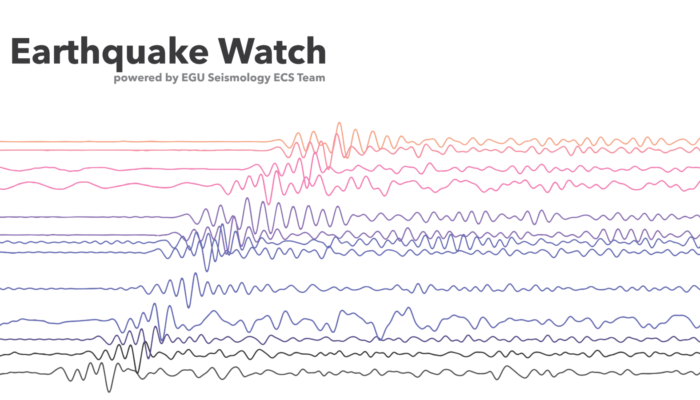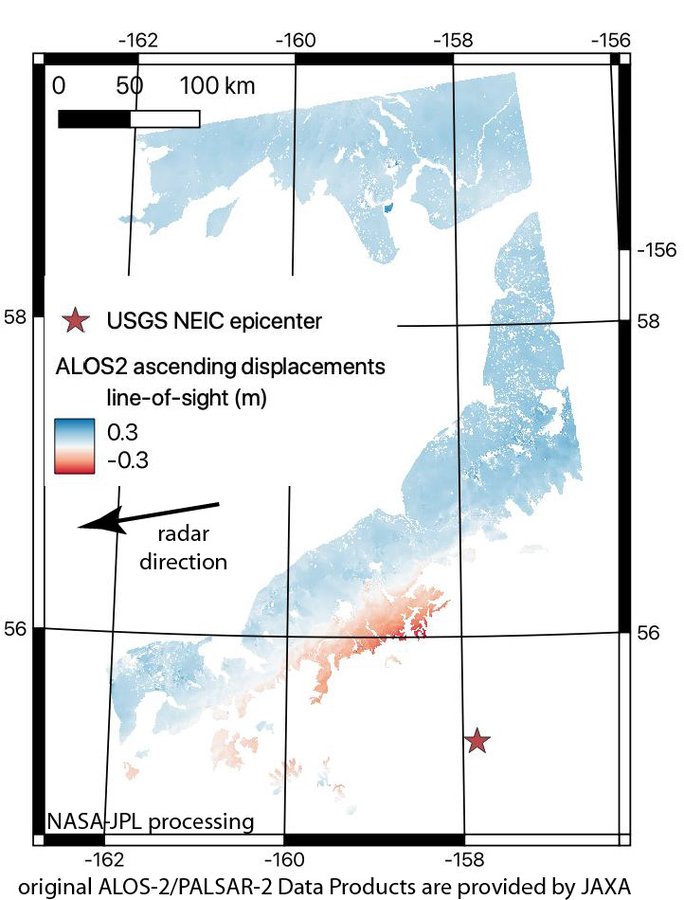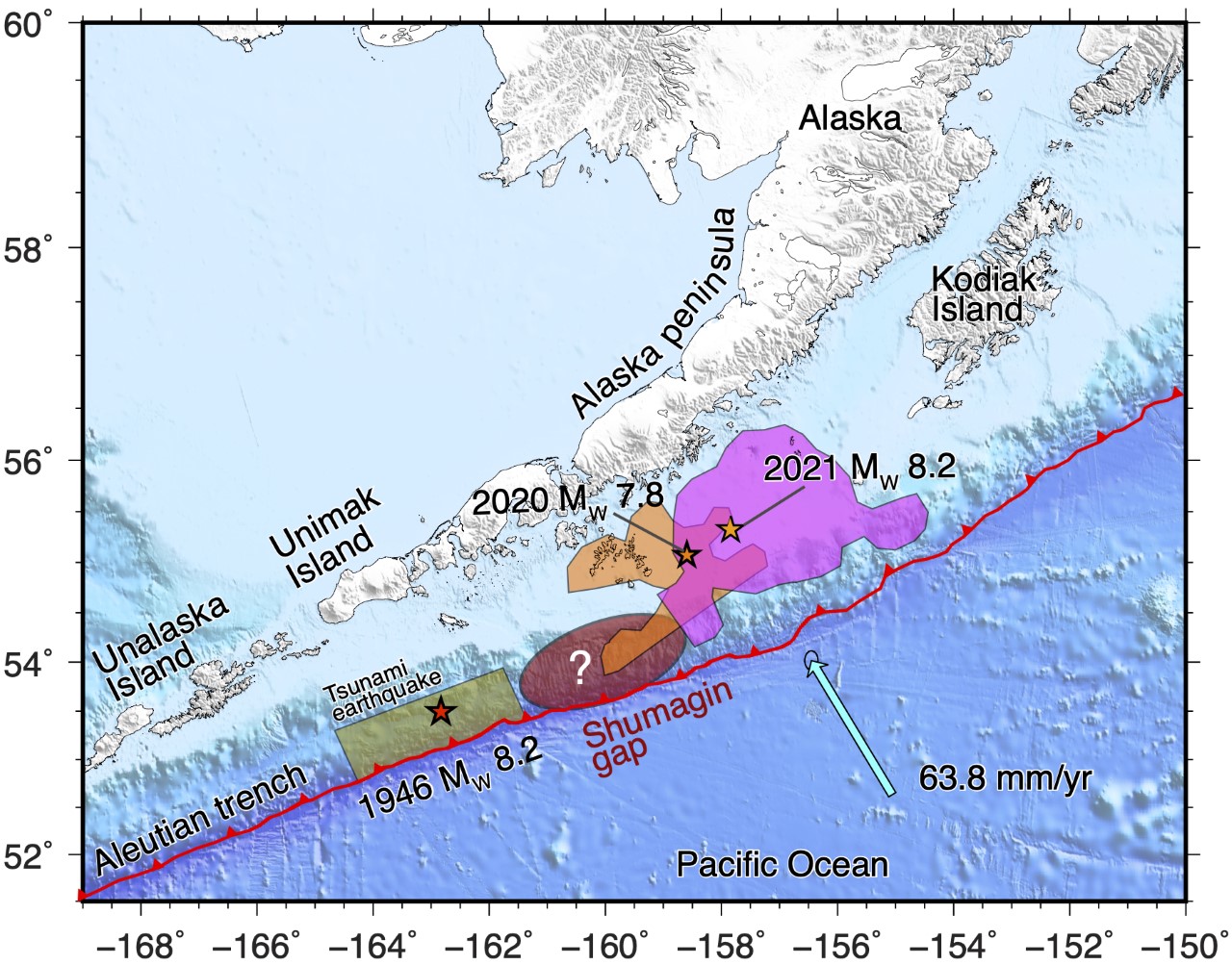
One year ago, we started a series of blog posts synthesising the main results and discussions about the most significant earthquakes recorded recently, previously called “Earthquake of the month” and now known as “Earthquake Watch.” In our first edition, we reported on the 2020 Simeonof earthquake M 7.8 that occurred in Alaska (read here), and today we return to the same region with another interesting earthquake.

Figure 1 | Seismicity in Alaska. Grey areas show historical earthquakes in the area. Black stars correspond to the 2020 earthquakes that occurred west of the 2021 M8.2 event (red star). The seismicity associated with the 2020 and 2021 sequences is shown in grey and red circles, respectively. Credits: Alaska Earthquake Center.
On July 29th at 06:15 (UTC), a large earthquake M8.2 occurred in the Alaska Peninsula, affecting the towns of Perryville and Chignik (Figure 1). This event is not only the most significant recorded since August 19th, 2018 (USGS), but it is also the largest U.S. earthquake recorded in 50 years (Alaska Earthquake Center). The mainshock was followed by more than 250 aftershocks larger than M2.0 (Alaska Earthquake Center). You can view a 3D visualisation of seismic waves propagating from the earthquake across the seismic stations in the Alps here.
The event took place along the Aleutian megathrust, a region well-known for its seismic activity, revealed by the geological record of tsunami deposits (e.g. Nelson et al. 20151). Early results like the hypocenter location and focal mechanism show that this event occurred in the Semedi segment, where the last significant event was the 1938 M8.3 megathrust earthquake. However, the slip distribution models indicate a compact rupture in the deeper region of the megathrust (~30 km depth), which have an extension of about 150 km long and 100 km wide, and a maximum slip of 4.8 m (USGS). Rupture mainly propagates to the northeast of the hypocenter, in the opposite direction of the Shumagin Gap.

Figure 2 | Ground displacement from InSAR data. They are corrected for ionospheric effects. Displacement values on the islands may not be reliable. The original ALOS2 data (SLC in this case) is copyrighted by JAXA. They provided this data under a license for NASA research. Credits: Dr. Eric J. Fielding @EricFielding
The fault size of this event is explained by teleseismic and regional observations and the deformation pattern in the Alaska Peninsula. For example, the GPS station AB13 in Chignik recorded a maximum horizontal displacement of about 43 cm oriented to the southeast and an offset of ~10 cm of subsidence in the vertical component (Brendan Crowell @bwcphd). These observations were also supported by the ground displacement obtained from InSAR analysis, which shows 10-20 cm of subsidence in the Alaska Peninsula (Figure 2).
A deep earthquake confined underground on the plate boundary like this event usually generates strong seismic waves and shaking but has a limited tsunami excitation because the rupture propagation does not reach the trench or the updip portion of the megathrust. This explains a minor tsunami of a few centimetres at a regional scale of 15 cm high, observed at Sand Point tide gauge (NOAA). Although the 1938 M8.3 and the 2021 Perryville earthquakes seem to occur in the same area, the 1938 event ruptured at a shallow depth within a high interseismic slip deficit (Freymueller et al., 20212).
Figure 3 | Tsunami and seismic surface waves in DART records. The panels show Rayleigh waves in DART records (filtering tides and tsunami). Credits: Amir Salaree @amirsalaree
Figure 3 shows how the tsunami sensors near Alaska recorded the tsunami amplitudes and the seismic surface waves. According to the analysis from the DART records of Dr Amir Salaree (@amirsalaree), the larger and sharper amplitudes to the northeast could indicate rupture directivity in that direction, supporting the inference from the coseismic slip distribution models and back projection products from IRIS.
What’s happening updip of the 2021 M8.2 earthquake?
Preliminary models suggest a deep event in the interplate interface that did not rupture the shallow plate boundary or cause a large seafloor deformation. Researchers are keeping their attention on a strongly coupled shallow zone, interseismic creeping, slow slip events, and other physical phenomena that are hard to observe without seafloor geodetic observations. Moreover, these shallow zones, which are characterised by an accretionary prism, poorly consolidated, weak and overpressured sediments could inhibit shallow slip in this case (see Li et al., 20153 and Li et al., 20184).
What is the relationship between the 2020 sequence and the 2021 M8.2 earthquake?
The possible interaction between the 2020 sequence, including the M7.8 (July 22nd) and M7.6 (October 19th) events in the Shumagin gap, and the 2021 M8.2 Perryville earthquake (Figure 4), represents an interesting problem. By investigating the spatial distribution of these earthquakes, their foreshock activity, nearby ruptures, and their extent, researchers will better understand the interaction between seismic behaviour and aseismic activity in the short and long term (e.g. Klein et al., 20215).

Figure 4 | The 2021 Perrysville earthquake has similar patterns to the 1938 earthquake (Figure 5, orange contour). Grey is slip deficit inferred from geodesy. Credits: Sylvain Barbot @quakephysics.
TOP 3 – July earthquakes
Perryville, Alaska – July 29th – M8.2
Punta de Burica, Panama – 21st July – M6.7
Tingloy, Philippines – 23rd July – M6.7
References
1 Nelson, A.R., Briggs, R.W., Dura, T., Engelhart, S.E., Gelfenbaum, G., Bradley, L.-A., Forman, S.L., Vane, C.H., and Kelley, K.A., 2015, Tsunami recurrence in the eastern Alaska-Aleutian arc: A Holocene stratigraphic record from Chirikof Island, Alaska: Geosphere, v. 11, no. 4, p. 1172–1203, doi:10.1130/GES01108.1.
2 Freymueller, J.T., Suleimani, E.N. and Nicolsky, D.J., 2021. Constraints on the Slip Distribution of the 1938 MW 8.3 Alaska Peninsula Earthquake from Tsunami Modeling. Geophysical Research Letters, 48(9), p.e2021GL092812.
3 Li, J., D. J. Shillington, A. Bécel, M. R. Nedimović, S. C. Webb, D.M. Saffer, K. M. Keranen, and H. Kuehn (2015), Downdip variations in seismic reflection character: Implications for fault structure
and seismogenic behaviour in the Alaska subduction zone, J. Geophys. Res. Solid Earth, 120, 7883–7904, doi:10.1002/2015JB012338.
4 Li, J., Donna J. Shillington, Demian M. Saffer, Anne Bécel, Mladen R. Nedimović, Harold Kuehn, Spahr C. Webb, Katie M. Keranen, Geoffrey A. Abers; Connections between subducted sediment, pore-fluid pressure, and earthquake behaviour along the Alaska megathrust. Geology 2018;; 46 (4): 299–302. doi: https://doi.org/10.1130/G39557.1
5 Klein, E., Potin, B., Pasten-Araya, F., Tissandier, R., Azua, K., Duputel, Z., … & Vigny, C. (2021). Interplay of seismic and a-seismic deformation during the 2020 sequence of Atacama, Chile. Earth and Planetary Science Letters, 570, 117081.
